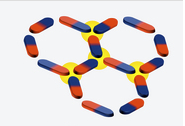2013
Markus Niederberger receives Goldene Eule

The ETH Zurich’s student association (VSETH) has selected Markus Niederberger (Associate Professor and Chair of the Laboratory for Multifunctional Materials) as a recipient of the “Goldene Eule”.
Treffpunkt Science City: "Materials – Tracking down the Perfect Material"

Materials at their limits. Lectures and demonstrations, Science City Junior for childern 5 years and older (German)
Jan Vermant appointed Full Professor

The Department of Materials is happy to announce that on September 25/26, the Board of the Swiss Federal Institutes of Technology has appointed Jan Vermant (*1968), currently Full Professor at the Katholieke Universiteit Leuven, Belgium, as Full Professor of Soft Materials.
IBM Research Prize 2013 for Carlo Weingart

Carlo Weingart, Materials Theory group of Prof. Nicola Spaldin, is awarded the IBM Research Prize 2013 for his Master thesis "Origin of spin canting in multiferroic perovskites". This outstanding achievement will be awarded at the ETH-Tag on November 16, 2013.
Focus Nano: Miniature material design

Smaller isn’t always better in the world of nanomaterials. From a certain tininess, negative effects can outweigh the good. Prof. Ralf Spolenak of the Laboratory for Nanometallurgy and his team are thus looking for the optimum length scale for materials, where their properties improve before deteriorating again.
Ludwig Gauckler nominated Distinguished Life Member of the ACS

The Department of Materials is proud to announce that the Board of the American Ceramic Society has nominated Prof. emerit. Ludwig J. Gauckler to be a Distinguished Life Member of the Society.
Lucio Isa appointed Assistant Professor

The Department of Materials is happy to announce that on May 22/23, the Board of the Swiss Federal Institutes of Technology has appointed Lucio Isa as an Assistant Professor (SNF) of Interfaces, Soft Matter and Assembly.
Tiny Magnets as a Model System

The model: rings made from six nanoscale magnetic rods, whose north and south poles attract each other. At room temperature, the magnetisation direction of each of these tiny rods varies spontaneously. Scientists at the Laboratory for Mesoscopic Systems and other groups were able to observe the magnetic interactions between these active rods in real time.
Germanium made compatible

Researchers at the Laboratory for Nanometallurgy has managed to make Germanium suitable for lasers. This could enable microprocessor components to communicate using light in the future, which will make the computers of the future faster and more efficient.
New material gets itself into shape

Inspired by plant components that respond to external stimuli, members of the Complex Materials Groups have devised a new method for producing composite materials from a variety of materials that adopt a pre-programmed shape autonomously.
Members of Complex Materials Group receive Spark Award 2013

Rafael Libanori, Randall Erb and André Studart from the Laboratory for Complex Materials have received the "Spark Award 2013" for the invention of composites with extreme mechanical gradients.